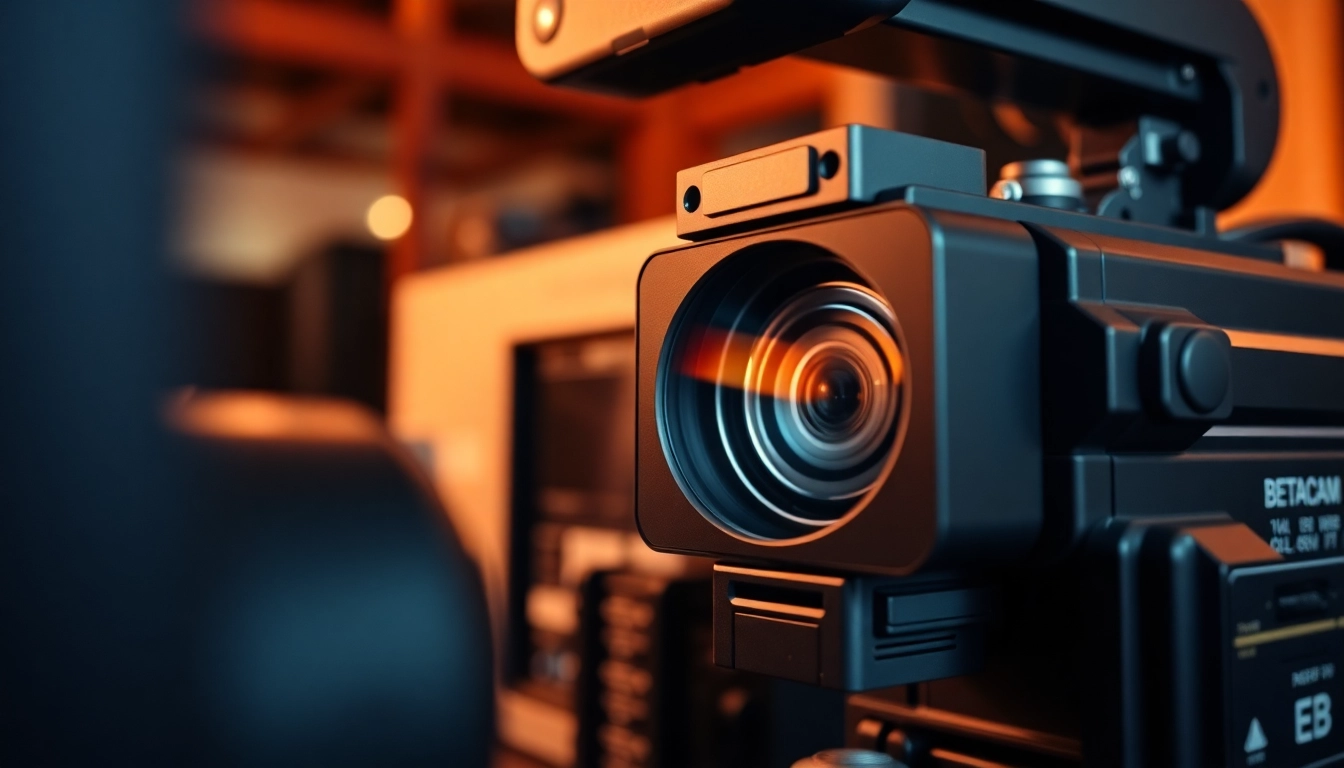Understanding Betacam Tapes
What Are Betacam Tapes?
Betacam tapes are a series of video tape formats developed by Sony, starting in the early 1980s. They gained immense popularity among television broadcasters and production companies due to their superior image quality and reliability. The first format, Betacam, was introduced in 1982, followed by several variants, including Betacam SP and Digital Betacam. Notably, Betacam SP emerged as the industry standard for professional video due to its enhanced performance, particularly in terms of color reproduction and reduced noise. As digital technologies advanced, the need for high-quality video storage formats became apparent, leading to the digitization of content originally recorded on these tapes.
Types of Betacam Tapes and Their Uses
Betacam tapes encompass a range of formats, each designed for specific professional requirements:
- Betacam: The original format, ideal for news broadcasting.
- Betacam SP: Enhanced version that provided better audio quality and image clarity, widely used from the late 1980s through the 1990s.
- Betacam SX: A more advanced tape format that offers additional features for digital encoding, commonly used in versatile shooting environments.
- Digital Betacam: A digital version of Betacam, popular in high-end video production and broadcast settings.
Each of these formats has been vital for video production, but as technology has evolved, so has the urgency to convert these historic tapes into digital formats for preservation and accessibility.
Why Convert Betacam to Digital?
The conversion of Betacam tapes to digital format offers numerous advantages:
- Preservation: Analog tapes can degrade over time, leading to loss of quality and ultimately, loss of content. Digitization preserves the original material against environmental factors.
- Accessibility: Digital files are easily accessible on various devices and platforms, unlike physical tapes which require specific playback equipment.
- Improved Quality: Professional conversion processes can enhance the visual quality of the footage through upscaling and noise reduction.
- Archivable: Digital files are easier to store, search, and share, ensuring your valuable memories and content are safe for future generations.
For those looking to transition from
Betacam to Digital, understanding the importance of this conversion is crucial.
How Betacam to Digital Conversion Works
The Conversion Process Explained
The conversion process from Betacam to digital involves several key steps:
- Assessment: Evaluate the condition of the tapes to determine the best conversion method.
- Playback: High-quality playback equipment is used to capture the video and audio signals without losing fidelity.
- Digitization: The analog signal is converted to a digital format using specialized hardware or software. This process often involves real-time playback and can utilize professional video capture cards.
- Editing and Enhancement: After digitization, the content may undergo editing for quality enhancement, including color correction and noise reduction.
- Output Options: The final digital files can be saved in various formats (MP4, AVI, MOV, etc.) and stored on multiple media, including USB drives, external hard drives, or cloud services.
Choosing the Right Equipment for Conversion
Choosing the right equipment for Betacam to digital conversion is crucial. High-definition playback decks and automation tools are essential for ensuring quality transfers. Key equipment includes:
- Professional Betacam Decks: These are designed specifically to play Betacam tapes, ensuring that signal integrity is maintained during transfer.
- Video Capture Devices: High-end capture devices can convert analog video signals to digital formats without quality loss.
- Post-Production Software: Editing and enhancement software can correct flaws during conversion and format videos for various platforms.
Quality Factors in Digital Conversion
Several factors influence the quality of the digital conversion:
- Playback Quality: The quality of the Betacam deck used during the transfer significantly affects the final product.
- Capturing Resolution: The resolution at which the video is captured can determine the clarity of the final digital file.
- Encoding Settings: Proper encoding settings ensure that the digital file accurately reflects the original tape’s quality.
- Post-Processing Techniques: Techniques such as noise reduction and color correction can vastly improve the quality of the digital output.
Selecting a Reliable Service Provider
Key Criteria for Choosing a Betacam to Digital Service
Choosing the right service provider for Betacam to digital conversion is vital for achieving high-quality results. When selecting a service, consider these criteria:
- Experience: Look for providers with a proven track record in video conversion, particularly with Betacam formats.
- Equipment Use: Ensure they use professional-grade equipment to protect the quality of your tapes.
- Customer Support: Reliable customer service is essential for addressing concerns before, during, and after the conversion process.
- Clear Pricing: Be sure to understand their pricing model, including any additional fees for enhancements or rush services.
Comparing Service Providers: What Matters?
When comparing service providers, consider factors beyond just price. Look for comprehensive services that include:
- Transparent pricing without hidden fees.
- Customer reviews and testimonials highlighting their experiences.
- Sample work or portfolios to gauge quality.
- Turnaround times that fit your project deadlines.
Customer Reviews and Testimonials
Customer reviews and testimonials can serve as reliable indicators of a service provider’s quality and reliability. Look for:
- Reviews specifically mentioning Betacam to digital services.
- Consistent positive feedback regarding quality and customer service.
- Responses to negative reviews, which can reflect how the company values customer satisfaction.
Cost Considerations for Betacam to Digital Services
Typical Pricing Models Explained
The cost of Betacam to digital conversion services can vary significantly based on several factors:
- Type of Tape: Different formats may incur different costs, primarily due to the equipment required for playback.
- Length of the Content: The total run time of the tapes being converted is a major factor in pricing.
- Additional Services: Costs may increase if you choose enhancements such as editing or color correction.
Understanding Additional Costs
In addition to the base price, there may be other costs associated with the conversion process:
- Shipping Fees: If you are sending tapes to a service provider, consider shipping costs and insurance for valuable content.
- Storage Fees: If you want your digital files stored externally, be aware of any monthly or annual fees.
- Upgrade Costs: Some providers offer different pricing tiers based on the quality of output desired, so be sure to clarify this beforehand.
Value for Money: Is It Worth It?
Deciding whether to invest in Betacam to digital conversion comes down to the value you place on your content. Consider the following:
- Emotional Value: If the tapes contain irreplaceable memories, timely investment in conversion is invaluable.
- Historical Significance: Tapes containing important content, such as historic events or family milestones, are worth preserving digitally.
- Future Accessibility: Digital content can be easily accessed and shared, making the initial investment more justifiable over time.
Long-Term Benefits of Digital Conversion
Archiving and Preserving Your Video Content
Digital conversion allows for effective archiving of video content, ensuring that the media is preserved in formats that won’t degrade over time. Digital archiving can provide significant flexibility:
- Cloud Storage: Media can be stored in the cloud, allowing for easy access from anywhere.
- Multiple Copies: Easy to create backups ensures your content is safe from physical damage.
- Long-Term Accessibility: Digital content can be preserved for years without quality loss, unlike magnetic tapes that require specific environmental conditions.
Accessibility of Digital Files vs. Tapes
Digital files greatly outperform physical tapes in terms of accessibility:
- Device Compatibility: Digital files can be played on modern devices, whereas Betacam tapes require old equipment.
- Searchability: Digital content can be indexed for easy searching, making it a faster option for retrieval.
- Online Sharing: Digital files can be easily shared across platforms, enhancing collaboration and viewership.
The Future of Video Content Management
With the continuous evolution of technology, the management of video content is shifting towards digital-centric solutions:
- Automation and AI: Future video content management will likely incorporate automation for organization and retrieval, making handling extensive libraries more efficient.
- Enhanced Sharing: Digital formats facilitate easier sharing through online platforms, adapting to the current consumption trends.
- Sustainability: Transitioning to digital contributes to a more sustainable model by reducing the need for physical media.




